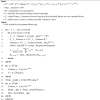Brain age gap estimation using attention-based ResNet method for Alzheimer's disease detection
- PMID: 38833039
- PMCID: PMC11150363
- DOI: 10.1186/s40708-024-00230-1
Brain age gap estimation using attention-based ResNet method for Alzheimer's disease detection
Abstract
This study investigates the correlation between brain age and chronological age in healthy individuals using brain MRI images, aiming to identify potential biomarkers for neurodegenerative diseases like Alzheimer's. To achieve this, a novel attention-based ResNet method, 3D-Attention-Resent-SVR, is proposed to accurately estimate brain age and distinguish between Cognitively Normal (CN) and Alzheimer's disease (AD) individuals by computing the brain age gap (BAG). Unlike conventional methods, which often rely on single datasets, our approach addresses potential biases by employing four datasets for training and testing. The results, based on a combined dataset from four public sources comprising 3844 data points, demonstrate the model's efficacy with a mean absolute error (MAE) of 2.05 for brain age gap estimation. Moreover, the model's generalizability is showcased by training on three datasets and testing on a separate one, yielding a remarkable MAE of 2.4. Furthermore, leveraging BAG as the sole biomarker, our method achieves an accuracy of 92% and an AUC of 0.87 in Alzheimer's disease detection on the ADNI dataset. These findings underscore the potential of our approach in assisting with early detection and disease monitoring, emphasizing the strong correlation between BAG and AD.
Keywords: 3D-Resnet; Alzheimer’s disease; Attention; Brain age gap; Structural MRI.
© 2024. The Author(s).
Conflict of interest statement
The authors declare no competing interests.
Figures











References
LinkOut - more resources
Full Text Sources
Miscellaneous

